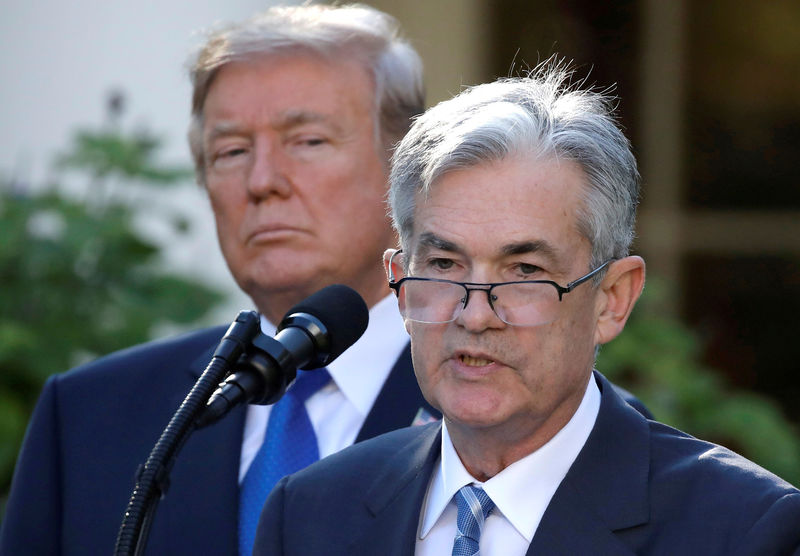 © Reuters. FILE PHOTO: FILE PHOTO: U.S. President Donald Trump looks on as Jerome Powell, his nominee to become chairman of the U.S. Federal Reserve, speaks at the White House in Washington
© Reuters. FILE PHOTO: FILE PHOTO: U.S. President Donald Trump looks on as Jerome Powell, his nominee to become chairman of the U.S. Federal Reserve, speaks at the White House in WashingtonBy Ann Saphir and Howard Schneider
WASHINGTON (Reuters) – With U.S. stocks well down from their record highs in September and key elections less than two weeks away, President Donald Trump has stepped up his criticism of the Federal Reserve’s interest rate increases and of Jerome Powell, the man he picked to lead the central bank.
Here are some key questions about Trump’s verbal attacks.
What is Trump’s criticism of the Fed?
Trump says the Fed is raising rates too fast, blunting the economic stimulus from tax cuts and deregulation, and making life harder for his administration as the tariffs resulting from the U.S. trade war with China and other countries begin to bite.
In an interview this week with the Wall Street Journal, Trump also complained that the Fed, which has been raising rates steadily during his term after holding them near zero throughout much of former President Barack Obama’s two terms in office, is making it harder for the United States to pay off its debt.
Is there any evidence the Fed is impeding the economy?
It is true that higher rates will eventually cool the economy, which grew at an annualized rate of 4.2 percent in the second quarter, twice its estimated potential. Many Fed policymakers expect higher borrowing costs to begin to restrain growth after two or three more rate hikes. Overall financial conditions have been loose and unemployment has fallen to its lowest levels in 49 years, even as the Fed increased rates three times under Powell. (Graphic: Trump’s war (of words) on the Fed – https://tmsnrt.rs/2PlZ6jb)
What can Trump do to influence Fed policy?
Indirectly, the U.S. president can gradually change the composition of the policymaking board with successive appointments, picking candidates that favor lower rates and looser policy. However, board members appointed by Trump so far have broadly sided with Powell. Trump has nominated three other candidates to fill the remaining open spots on the Fed’s board of governors. Two of them – Kansas banking regulator Michelle Bowman and former Fed staffer Nellie Liang – are not known to have strong rate policy preferences, while a third, Carnegie Mellon University’s Marvin Goodfriend, is widely considered a proponent of higher rates.
Trump has no say in the appointments of regional Fed presidents, who control five of the nine current votes on Fed policy. They would control five of 12 votes once all seats on the Fed board are filled.
Trump could try to fire Powell “for cause” under the Federal Reserve Act, though prior court decisions involving other agencies indicate disagreements over policy would not meet such a standard. A long-shot option, given how unsettling it would be for financial markets, would be to convince Congress to amend the act to allow the easier firing of the Fed chairman.
Have other U.S. presidents criticized the Fed and pressured it to change course, and with what effect?
In recent decades, U.S. presidents have taken a hands-off approach to Fed policy, but some in the more distant past were occasionally vocal in their displeasure or impatience with the central bank. George H.W. Bush blamed his 1992 election defeat on then-Fed Chairman Alan Greenspan, and Lyndon B. Johnson clashed with Fed chief William McChesney Martin over raising rates in 1965.
George Washington University political scientist Sarah Binder, who published a book on the Fed’s relations with elected officials, said that while Trump’s tweets and media outbursts gain much attention, they fall short of the in-person demands presidents in the 1960s and 1970s made of Fed chiefs.
Perhaps most significantly, President Richard Nixon replaced Martin with Arthur Burns, who caved in to White House pressure for low rates in what is widely regarded as a policy mistake that fed runaway inflation.
How is the Fed responding and what are the risks from Trump’s attacks?
So far, Trump’s verbal salvoes have had no discernible impact on the Fed, which has been sticking to its plan of gradually lifting borrowing costs to levels it considers more appropriate for a healthy, growing economy. One risk is that if Trump persists in his criticism, investors may begin to wonder whether the Fed will continue to stand its ground, creating uncertainty about the direction of U.S. monetary policy and potentially hurting market confidence.
Source: Investing.com




























